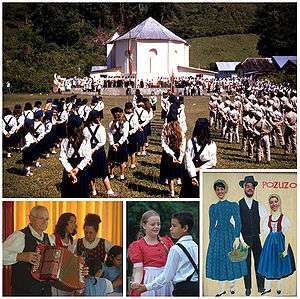German Peruvians
|
| |
| Total population | |
|---|---|
| (240,000[1]) | |
| Regions with significant populations | |
| Lima, Oxapampa, Pozuzo, Villa Rica, Moyobamba, Arequipa, Puno | |
| Languages | |
| Spanish, German, Austrian German | |
| Religion | |
| Roman Catholicism, Protestantism, Judaism |
German Peruvians are Peruvian citizens of full or partial German ancestry. In general, the term is also applied to descendants of other German-speaking immigrants, such as Austrians or Swiss. The phrase may refer to someone born in Peru of Austrian, German or Swiss descent or to someone who has immigrated to Peru from German speaking countries.
History
Since independence Germans had been immigrating to Lima on a small scale. the first wave of immigration was in 1853, organized by then-president Ramon Castilla. These immigrants established themselves in the cities of Tingo Maria, Tarapoto, Moyobamba, and in the department of Amazonas. Barón Cosme Damián Freiherr Schutz von Holzhausen, the leader of the immigration movement, consulted with the then Peruvian Minister of Foreign Relations, Manuel Tirado. The meeting's purpose was to colonize the central jungle to better link the Pacific and Atlantic coasts. The colonists would end up colonizing Pozuzo. In 1854, the first immigration contract was signed between the Baron and then-president José Rufino Echenique. The next year, in 1855, this contract was nullified as Echenique had been ousted and Ramon Castilla had assumed the presidency again. The Baron signed a new contract with the new president on December 6, 1855. According to the contract each colonist would be reimbursed by the government for the cost of the voyage from Europe to Pozuzo, the construction of a new highway from Cerro de Pasco to Pozuzo, each colonist 15 years old or older would receive 15 pesos, the distribution of 140 square miles (360 km2) land between the colonists of which they would have legal ownership, exemption for the first six months of taxes, and the responsibility to build schools, churches, and other basic needs. The government, however, required that the colonists be Catholic and workers skilled at a trade. To make this project possible the Baron was hired by the Peruvian government to oversee the colonization, paying him a salary of 2,400 pesos annually. The first wave of colonists departed Antwerp in 1857 and arrived in the Peruvian port of Callao two months later. The third wave of immigrants to the jungle occurred in 1868, taking the same route as the second wave of immigrants did. In later years, the descendants of the German immigrants would go on to found new cities throughout the central jungle such as Oxapampa and Villa Rica.
Throughout the history of Peru, particularly in the 19th and 20th centuries, a substantial number of German immigrants have settled in other parts of Peru, primarily in Lima. Also, many of these German immigrants have Jewish heritage. A large part of Jewish Peruvians are of German descent.
The Peruvian population of German descent is 160,000 people, while the descendants of Austro-German migration to the area of Oxpampa Pozuzo are 25,000 people.
Education
German schools in Peru:
- Colegio Peruano-Alemán Beata Imelda
- Deutsche Schule Lima Alexander von Humboldt (Lima)
- Deutsche Schule Max Uhle Arequipa
Notable German Peruvians
German Peruvian institutions and associations
- Instituto Superior Tecnologico Privado Peruano
- Colegio Peruano Alemán - Alexander von Humboldt
- Colegio Waldorf Lima
- Asociación Peruano Alemán Leopoldo Krause
- Colegio Peruano Alemán "Beata Imelda"
- Instituto Cultural Peruano Aleman
- Colegio Peruano-Alemán "Max Uhle"
- Colegio Peruano Alemán Augusto Weberbauer
- Club Peruano Aleman
- CAPA - Centro de Amistad Peruano Alemán
- Cámara de Comercio e Industria Peruano-Alemana
- Archivo de la Inmigración Alemana en el Perú
- Asociación Cultural Johannes Gutenberg
- Asociación Médica Peruana-Alemán
- Beneficencia peruano-alemana / Deutsch-peruanischer Hilfsverein
- Centro Mallqui
- Fundación Brandt
- Humboldt Club del Perú
- Instituto Cultural Peruano Alemán de Arequipa
- Cultural Acupari
- Agro Acción Alemana / Deutsche Welthungerhilfe (DWHH)
- Comisión Brandt
- Instituto Goethe
References
- ↑ Erwin Dopf. "Deutsche Einwanderung in Peru". Peru-spiegel.de. Retrieved 2016-01-07.
